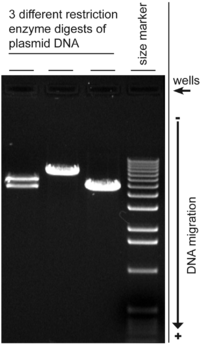
Photo from wikipedia
The GeLC-MS workflow, which combines low-cost, easy-to-use sodium dodecyl sulfate (SDS)-polyacrylamide gel electrophoresis (SDS-PAGE) with liquid chromatography-mass spectrometry (LC-MS), is very popular in current bottom-up proteomics. However, GeLC-MS requires that… Click to show full abstract
The GeLC-MS workflow, which combines low-cost, easy-to-use sodium dodecyl sulfate (SDS)-polyacrylamide gel electrophoresis (SDS-PAGE) with liquid chromatography-mass spectrometry (LC-MS), is very popular in current bottom-up proteomics. However, GeLC-MS requires that PAGE-separated proteins undergo overnight enzymatic digestion in a gel, resulting in more than 20 h of sample preparation for LC-MS. In this study, we overcame the limitations of GeLC-MS by developing a rapid digestion workflow for PAGE separation of proteins using N,N'-bis(acryloyl)cystamine (BAC) cross-linked gels that can be solubilized by reductive treatment. Making use of an established workflow called BAC-DROP (BAC-gel dissolution to digest PAGE-resolved objective proteins), crude proteome samples were fractionated based on molecular weight by BAC cross-linked PAGE. After fractionation, the gel fragments were reductively dissolved in under 5 min, and in-solution trypsin digestion of the protein released from the gel was completed in less than 1 h at 70 °C, equivalent to a 90-95% reduction in time compared to conventional in-gel trypsin digestion. The introduction of the BAC-DROP workflow to the MS assays for inflammatory biomarker CRP and viral marker HBsAg allowed for serum sample preparation to be completed in as little as 5 h, demonstrating successful marker quantification from a 0.5 μL sample of human serum.
Journal Title: Journal of proteome research
Year Published: 2020
Link to full text (if available)
Share on Social Media: Sign Up to like & get
recommendations!